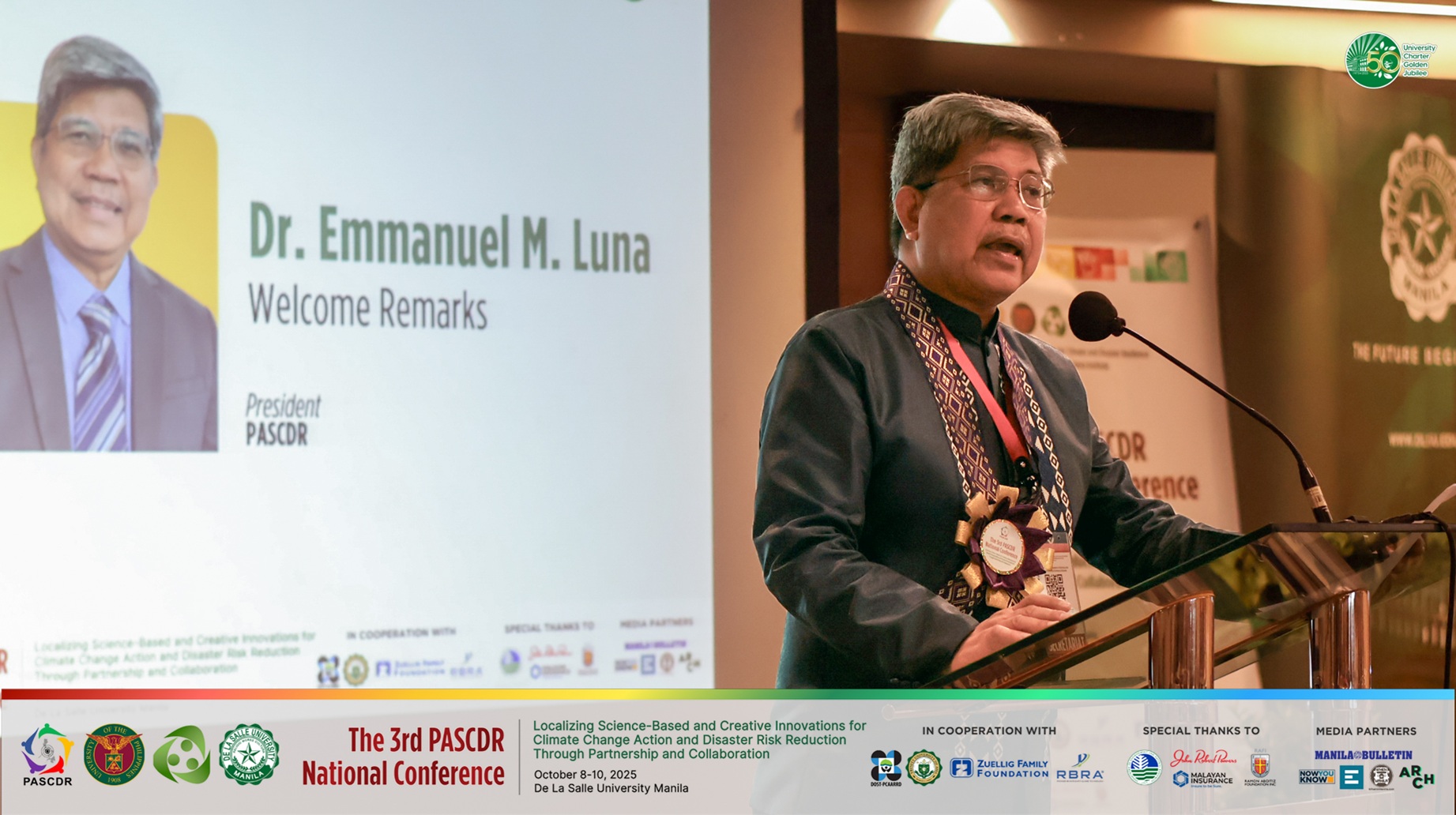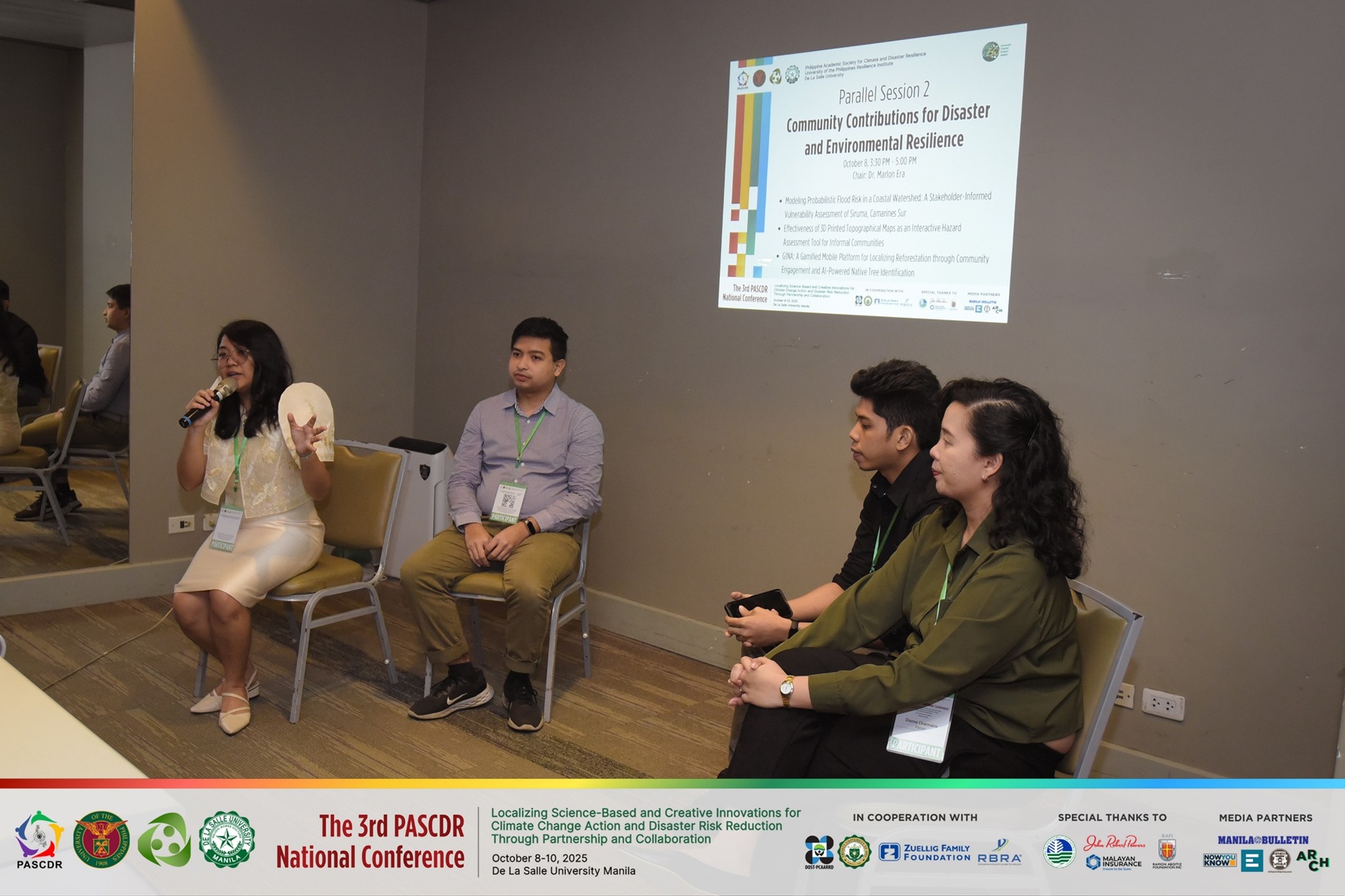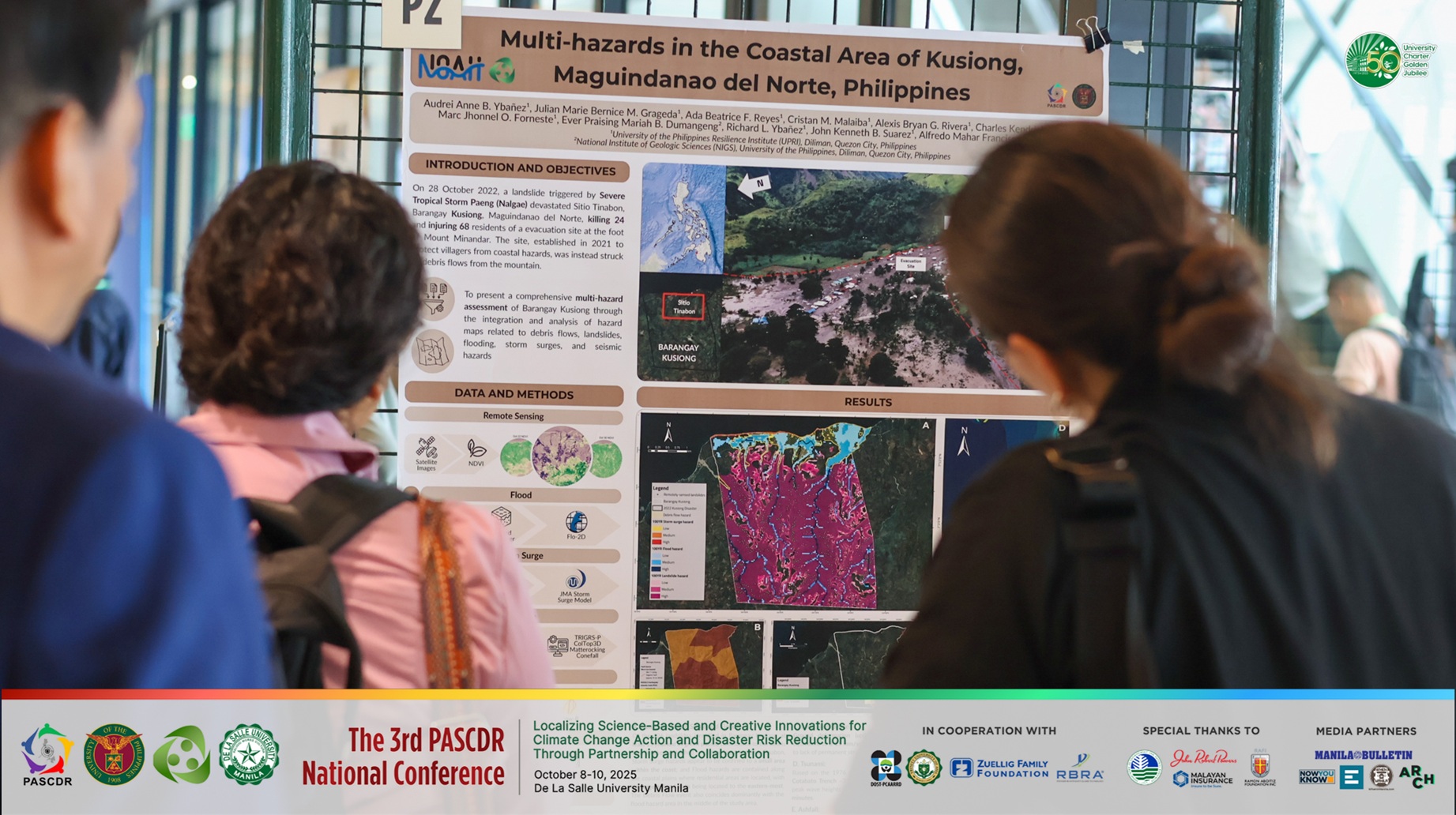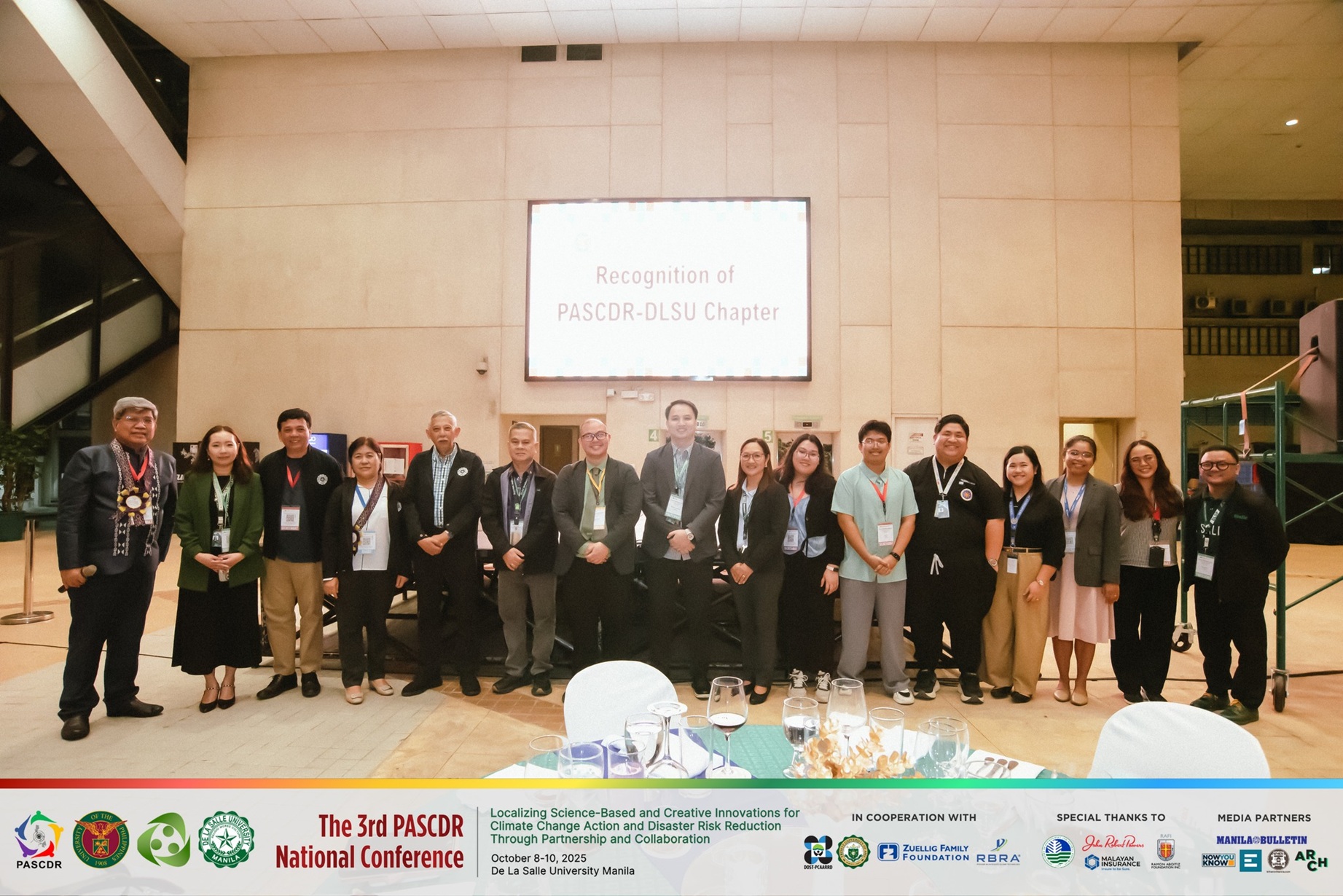By: UPRI-Education Division, PASCDR Secretariat

From October 8 to 10, 2025, the Philippine Academic Society for Climate and Disaster Resilience (PASCDR), in partnership with the UP Resilience Institute and De La Salle University (DLSU), held its 3rd National Conference at DLSU Manila with the theme “Localizing Science-Based and Creative Innovations for Climate Change Action and Disaster Risk Reduction Through Partnership and Collaboration.” The three-day event brought together 330 participants from academic, government, and civil society institutions to share insights on disaster risk reduction and climate change adaptation and mitigation (DRR-CCAM), enriching the national discourse on resilience.

Dr. Emmanuel M. Luna, PASCDR President and Co-founder, opened the conference proper by reflecting on the Society’s journey since its founding in 2019. From its beginnings as a platform for sharing research, PASCDR has evolved into a dynamic network promoting collaboration and capacity-building among students, academics, and professionals to advance resilience education.
Bro. Bernard Oca, DLSU President, also delivered an opening address, noting the significance of hosting the event during DLSU’s 50th Jubilee celebration. He emphasized how the conference aligns with the University’s goals, particularly those tied to the Sustainable Development Goals (SDGs) such as partnerships, quality education, and climate action. Dr. Marlon D. Era, Conference Director and Chair of DLSU’s Department of Innovation and Sustainability, then presented the conference overview and encouraged participants to actively engage in the discussions and open forum where “ideas evolve into collaborations and partnerships are strengthened for a more resilient and sustainable future.”


Across the three-day event, PASCDR featured diverse plenary, keynote, and parallel sessions (oral and poster presentations) led by experts who have contributed to addressing natural and human-induced hazards. Opportunities for collaboration and exchange of knowledge were provided to reinforce the participants’ skills in resilience-building initiatives. The parallel sessions in particular provided a platform for students, academics, and professionals from various sectors in sharing their respective studies, highlighting the interdisciplinary nature of climate and disaster resilience. This reflects PASCDR’s commitment to drawing DRR-CCAM insights from fields spanning the natural sciences to the humanities and social sciences.


Beyond the sessions, the conference also featured meaningful engagements such as the DLSU-PASCDR Chapter Induction, cultural performances, and the election of the new PASCDR Board of Trustees. PASCDR also had the privilege of showcasing the booths of its sponsors. These activities strengthened camaraderie among members and reaffirmed the Society’s commitment to collaborative leadership in resilience-building.
On the first day, Dr. Noralene M. Uy, Assistant Secretary for Policy, Planning, International Affairs, and Climate Change at the Department of Environment and Natural Resources (DENR), shared the agency’s ongoing efforts to strengthen the country’s ecosystems and natural defenses. She discussed DENR’s seven priority programs, which align with global and national frameworks such as the SDGs, Philippine Development Plan (PDP), Philippine Biodiversity Strategy and Action Plan (PBSAP), National Action Plan (NAP), and Nationally Determined Contribution Implementation Plan (NDCIP), ensuring that environmental protection remains central to climate resilience.
Dr. Antonio Gabriel M. La Viña, Associate Director for Climate Policy and International Relations and Head of the Klima Center, discussed “The International Court of Justice Speaks Out on Climate Justice: What Does It Mean for the Philippines and Its Corruption Crisis?” Dr. La Viña explained how international law reinforces state accountability on climate issues and cautioned that corruption, especially in infrastructure projects, undermines effective climate action. He stressed that achieving true climate justice requires transparency and responsible governance.
Dr. Alfredo Mahar Francisco A. Lagmay, Executive Director of the UP Resilience Institute, emphasized a whole-of-society and science-based approach to disaster and climate resilience. He urged collaboration among state universities and colleges (SUCs), scientists, and local governments to develop practical, evidence-based plans. Dr. Lagmay highlighted the importance of integrating local strategies such as the LDRRMP, CDRA, and LCCAP across sectors and encouraged using the 5% LDRRM Fund not only for emergency response but also for research and innovation that strengthen local preparedness.
On the second day, Dr. JC Gaillard, Professor at the University of Auckland, opened the plenary sessions with “Building Resilience at the Local (Community) Level.” Dr. Gaillard challenged the notion that “disaster” has a direct Filipino translation, pointing out that sakuna and kalamidad originate from Sanskrit and Spanish. He noted that Filipinos define disasters through lived experiences such as their experiences with storms, earthquakes, and rains—showing how local contexts shape the understanding of disaster and climate resilience. Dr. Maria Mangahas, Professor of Anthropology at UP Diliman, responded by emphasizing that the lack of a direct translation should not be seen as a gap but as a reflection of how deeply Filipinos connect disasters to social and cultural realities.
In his talk, Caesar Agnir Jr., Director of the Office of Civil Defense’s Disaster Preparedness Service, discussed how government collaboration with academia, civil society, and the private sector strengthens resilience-building initiatives. According to Director Agnir, combating the effects of disasters and climate change should be collaborative in essence. He also highlighted that scientific research, community-based approaches, and technological innovation are essential for effective disaster management.
The final day featured plenary sessions from Dr. Emmanuel M. Luna, Loreine B. dela Cruz, Executive Director of the Center for Disaster Preparedness Foundation, and Dr. Kristoffer B. Berse, Dean of UP Diliman’s National College of Public Administration and Governance (NCPAG). On the theme Partnership Towards Resilience, Dr. Luna explored how disasters are socially produced, rooted in inequality and systemic legacies. On the other hand, Ms. Dela Cruz emphasized the need for a “humanitarian reset” that prioritizes local collaboration as global funding shifts. Discussing the topic Disaster by Design: Unpacking Flood Control Corruption, Accountability, and Reform, Dr. Berse presented an eye-opening analysis of the ₱115 billion flood control allocation in the 2025 national budget, revealing concerns over “ghost projects” and calling for stronger transparency and accountability in infrastructure spending. He also announced the upcoming launch of ICARE, a multi-stakeholder consortium that will co-create and monitor reform efforts.

Over the past six years, PASCDR, through its national conferences, has been striving to strengthen and empower academic institutions into becoming the arm for institutional reform regarding the development of climate and disaster-resilient communities. In its first ever conference titled “SHARE. COLLABORATE. EMPOWER. Strengthening the Role of the Academe in Climate and Disaster Resilience”, the goal was merely to gather the academe and talk about its key role in DRR-CCAM scholarship and in shaping policies thereafter. Come the second conference with the theme, “From Discourses to Actions: Mobilizing the Academe for DRR-CCAM,” the conference goal then progressed toward mobilizing the academe and evaluating what it has already done in terms of actualizing research in DRR-CCAM. Now, in this recently held 3rd National Conference, the Society furthered its cause by summing up learnings from the previous conferences with localizing science-based and creative innovations for climate and disaster resilience.
The 3rd National Conference emphasized the importance of the experiences of local communities in relation to DRR-CCAM, and what partnership and collaboration can do to realize these goals. The conclusion of this conference assured participants that building resilience is not the task of a single sector but a shared responsibility that thrives on partnership, inclusivity, and innovation. Through continued collaboration, PASCDR remains steadfast in its mission to foster knowledge exchange and collective action toward a safer, more sustainable, and disaster-resilient Philippines.
IN COOPERATION WITH:
RBRA Structural Engineering Hub (Ruel B. Ramirez & Associates)
SPECIAL THANKS TO:
RAFI – Ramon Aboitiz Foundation Inc.
Department of Environment and Natural Resources (DENR)
John Robert Powers Philippines
Malayan Insurance (Philippines)
MEDIA PARTNERS:
